by Calculated Risk on 7/02/2012 11:30:00 AM
Monday, July 02, 2012
Construction Spending in May: Private spending increases, Public Spending declines
Catching up ... This morning the Census Bureau reported that overall construction spending increased in May:
The U.S. Census Bureau of the Department of Commerce announced today that construction spending during May 2012 was estimated at a seasonally adjusted annual rate of $830.0 billion, 0.9 percent above the revised April estimate of $822.5 billion. The May figure is 7.0 percent above the May 2011 estimate of $775.8 billion.Private construction spending increased while public spending decreased:
Spending on private construction was at a seasonally adjusted annual rate of $560.4 billion, 1.6 percent above the revised April estimate of $551.8 billion. ... In May, the estimated seasonally adjusted annual rate of public construction spending was $269.6 billion, 0.4 percent below the revised April estimate of $270.7 billion.
 Click on graph for larger image.
Click on graph for larger image.This graph shows private residential and nonresidential construction spending, and public spending, since 1993. Note: nominal dollars, not inflation adjusted.
Private residential spending is 61% below the peak in early 2006, and up 17% from the recent low. Non-residential spending is 28% below the peak in January 2008, and up about 30% from the recent low.
Public construction spending is now 17% below the peak in March 2009 and at a new post-bubble low.
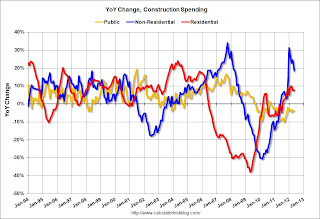 The second graph shows the year-over-year change in construction spending.
The second graph shows the year-over-year change in construction spending.On a year-over-year basis, both private residential and non-residential construction spending are positive, but public spending is down on a year-over-year basis. The year-over-year improvements in private non-residential is mostly related to energy spending (power and electric).
The year-over-year improvement in private residential investment is an important change (the positive in 2010 was related to the tax credit). Construction is now the "bright spot" for the economy, however the improvement in residential construction is being somewhat offset by declines in public construction spending.
ISM Manufacturing index declines in June to 49.7
by Calculated Risk on 7/02/2012 10:00:00 AM
This is the first contraction in the ISM index since the recession ended in 2009. PMI was at 49.7% in June, down from 53.5% in May. The employment index was at 56.6%, down from 56.9%, and new orders index was at 47.8%, down from 60.1%.
From the Institute for Supply Management: June 2012 Manufacturing ISM Report On Business®
Economic activity in the manufacturing sector contracted in June for the first time since July 2009; however, the overall economy grew for the 37th consecutive month, say the nation's supply executives in the latest Manufacturing ISM Report On Business®.
The report was issued today by Bradley J. Holcomb, CPSM, CPSD, chair of the Institute for Supply Management™ Manufacturing Business Survey Committee. "The PMI registered 49.7 percent, a decrease of 3.8 percentage points from May's reading of 53.5 percent, indicating contraction in the manufacturing sector for the first time since July 2009, when the PMI registered 49.2 percent. The New Orders Index dropped 12.3 percentage points in June, registering 47.8 percent and indicating contraction in new orders for the first time since April 2009, when the New Orders Index registered 46.8 percent. The Production Index registered 51 percent, and the Employment Index registered 56.6 percent. The Prices Index for raw materials decreased significantly for the second consecutive month, registering 37 percent, which is 10.5 percentage points lower than the 47.5 percent reported in May. Comments from the panel range from continued optimism to concern that demand may be softening due to uncertainties in the economies in Europe and China."
 Click on graph for larger image.
Click on graph for larger image.Here is a long term graph of the ISM manufacturing index.
This was below expectations of 52.0%. This suggests manufacturing contracted in June for the first time since July 2009.
This was a weak report, and the decline in new orders was especially significant.
Eurozone Recession: Record Unemployment, Manufacturing Shrinks
by Calculated Risk on 7/02/2012 09:04:00 AM
From Eurostat: Euro area unemployment rate at 11.1%
The euro area (EA17) seasonally-adjusted unemployment rate was 11.1% in May 2012, compared with 11.0% in April. It was 10.0% in May 2011. The EU27 unemployment rate was 10.3% in May 2012, compared with 10.2% in April4. It was 9.5% in May 2011.From the WSJ: Euro-Zone Data Show No Sign of Improvement
Eurostat estimates that 24.868 million men and women in the EU27, of whom 17.561 million were in the euro area, were unemployed in May 2012.
Activity at euro-zone factories continued to fall sharply in June, while the currency area's unemployment rate rose to a record high in May ...It is no surprise that Germany's export economy is starting to feel the impact of the eurozone recession. The "good" news is Spanish 10-year bond yields are down to 6.27%, and Italian yields are down to 5.71%.
In a particularly worrying sign for the currency bloc's economy, German manufacturing activity fell at its fastest rate in three years—the latest evidence that Europe's biggest national economy is braking ... The final reading of the manufacturing purchasing managers' index was 45.1 in June [below 50 is contraction]
And the ECB is expected to cut rates on Thursday.
Sunday, July 01, 2012
Monday: ISM Manufacturing, Construction Spending
by Calculated Risk on 7/01/2012 09:57:00 PM
The key report Monday will be the ISM Manufacturing survey. Most of the regional surveys were weak in June, and the ISM index will probably decline too.
• At 10:00 AM ET, the ISM Manufacturing Index for June will be released. The consensus is for a decrease to 52.0 from 53.5 in May.
• Also at 10:00 AM, Construction Spending for May will be released. The consensus is for a 0.2% increase in construction spending.
The Asian markets are green tonight. The Nikkei is up 0.3%, and the Shanghai Composite is up slightly.
From CNBC: Pre-Market Data and Bloomberg futures: the S&P 500 futures are down about 2, and Dow futures are down 23.
Oil: WTI futures are up to $84.37 (this is down from $109.77 in February, but up last week) and Brent is at $97.27 per barrel. According to a formula from Professor Hamilton, the price of Brent would suggest gasoline at $3.27 per gallon (the current national average price is $3.35, so even with the increase in Brent, gasoline prices will probably fall further).
Yesterday:
• Summary for Week Ending June 29th
• Schedule for Week of July 1st
For the monthly economic question contest (questions for July):
Housing: Investor Buying in Oakland
by Calculated Risk on 7/01/2012 05:16:00 PM
A report on investor buying in Oakland: Who Owns Your Neighborhood? The Role of Investors in Post-Foreclosure Oakland (ht picosec, Tom)
From the San Francisco Chronicle: Investors buying, renting many Oakland foreclosures
According to the Urban Strategies Council's report, real estate investors have purchased - usually with cash - 42 percent of the 10,508 homes in Oakland that went into foreclosure between January 2007 and October 2011.The report focuses on the impact of non-local ownership on Oakland neighborhoods. However, another impact of cash-flow investor buying, is that these properties will probably not be sold any time soon - and this keeps the level of inventory down in these communities. This is one of the reasons that inventory has declined sharply.
Many of these investors are turning the homes into rental properties ...
"They are massive landlords in neighborhoods that historically have had high rates of homeownership, and very few people are aware of the investor activity that's taking place under their feet," said Steve King, the organization's housing and economic development coordinator.
...
In its report, the Urban Strategies Council, which focuses on development issues in low-income urban areas, argues that banks and government-controlled financial institutions Fannie Mae and Freddie Mac could be doing more to help families buy foreclosed homes.
Among its recommendations: Expand programs that give owner-occupiers and nonprofits a "first look" at foreclosed homes before they go up for auction.
Yesterday:
• Summary for Week Ending June 29th
• Schedule for Week of July 1st
Update: Recovery Measures
by Calculated Risk on 7/01/2012 11:57:00 AM
By request, here is an update to four key indicators used by the NBER for business cycle dating: GDP, Employment, Industrial production and real personal income less transfer payments.
Note: The following graphs are all constructed as a percent of the peak in each indicator. This shows when the indicator has bottomed - and when the indicator has returned to the level of the previous peak. If the indicator is at a new peak, the value is 100%.
These graphs show that several major indicators are still significantly below the pre-recession peaks.
 Click on graph for larger image.
Click on graph for larger image.
This graph is for real GDP through Q1 2012. Real GDP returned to the pre-recession peak in Q3 2011, and has been at new post-recession highs for three consecutive quarters.
At the worst point - in Q2 2009 - real GDP was off 5.1% from the 2007 peak.
 Real GDP has performed better than other indicators ...
Real GDP has performed better than other indicators ...
This graph shows real personal income less transfer payments as a percent of the previous peak through the May report released Friday.
This measure was off 10.7% at the trough in October 2009.
Real personal income less transfer payments is still 3.7% below the previous peak.
 The third graph is for industrial production through May.
The third graph is for industrial production through May.
Industrial production was off over 17% at the trough in June 2009, and has been one of the stronger performing sectors during the recovery.
However industrial production is still 3.4% below the pre-recession peak.
 The final graph is for employment. This is similar to the graph I post every month comparing percent payroll jobs lost in several recessions.
The final graph is for employment. This is similar to the graph I post every month comparing percent payroll jobs lost in several recessions.
Payroll employment is still 3.6% below the pre-recession peak.
All of these indicators collapsed in 2008 and early 2009, and only real GDP is back to the pre-recession peak. At the current pace of improvement, industrial production will be back to the pre-recession peak in early 2013, personal income less transfer payments in 2014, and employment in 2015.
June Contest Winners: A Tie!
by Calculated Risk on 7/01/2012 10:00:00 AM
For the economic question contest in June, the leaders were (Congratulations all!):
First Place tie:
Jeremy Strouse
Bryant Dodson
Alexander Petrov
4th Place tie:
Walt Tucker
Bill Dawers
Bill Jefferies
Yesterday:
• Summary for Week Ending June 29th
• Schedule for Week of July 1st
And the first two questions for July:
Saturday, June 30, 2012
On Europe
by Calculated Risk on 6/30/2012 07:33:00 PM
It seems every time Europe has a summit, announces a new plan ... and then the details disappoint. As usual, the actual statement lacked details, but here are a couple of reviews:
From Charles Wyplosz: One more summit: The crisis rolls on
Reading the official documents from the June 28 summit requires linguistic and divination skills. The texts are convoluted and clearly aim at giving various positive impressions while shying away from deep commitments.There is much more in Wyplosz' post.
The clearest result is that EFSF/ESM funds can be used directly to support banks.
The summit attendees seem to have successfully drawn the conclusions that this was necessary from the disastrous impact of their mid-June decision on new lending Spanish authorities to shore up their banks.
...
At the end of the day, the summit was a little move in the right direction bank supervision, but keep watching; we still don’t know what will actually get put in place. There was nothing on collapsing Greece, nothing on unsustainable public debts in several countries, and no end in sight to recession in an increasing number of countries.
There was no knock-out winner in this summit, but on points I’d have to say that the winner is the crisis.
Paul Krugman adds: What Did the EU Summit Accomplish?
The main substantive thing was the agreement in principle to set up something more or less like a European version of the TARP, in which funds for bank recapitalization will be supplied by a consortium rather than lent to governments already overburdened with debt. Good move, and Irish bond buyers are especially happy. But even this doesn’t take effect right away.A comment a few weeks ago from Mark Dow keeps ringing in my ear: "Germany is now pot committed."
Also some bond purchases, but not by the ECB, so limited in size. So think of this as a very small version of quantitative easing.
So what we know even for the US is that the TARP and QE were perhaps enough to forestall disaster, but not to produce recovery — and Europe has the additional problem of huge needed realignments in competitiveness, which would be much easier if the ECB announced a dramatic loosening — which is didn’t.
Not nearly enough, then. Yet markets were buoyed.
I guess you can argue that this was sort of a downpayment — that it is the harbinger of bigger policy changes to come. I hope so.
Earlier:
• Summary for Week Ending June 29th
• Schedule for Week of July 1st
Schedule for Week of July 1st
by Calculated Risk on 6/30/2012 01:05:00 PM
Earlier:
• Summary for Week Ending June 29th
The key report for this week will be the June employment report to be released on Friday, July 6th. Other key reports include the ISM manufacturing index on Monday, vehicle sales on Tuesday, and the ISM non-manufacturing (service) index on Thursday.
The European Central Bank (ECB) holds a meeting on Thursday and is expected to cut the benchmark interest rate from 1.0% to 0.75%.
Happy Independence Day on Wednesday!
Reis will release their Q2 Office, Mall and Apartment vacancy rate reports this week. Last quarter Reis reported falling vacancy rates for apartments, a decline in vacancy rates for regional malls, and a slight decline in the office vacancy rate.
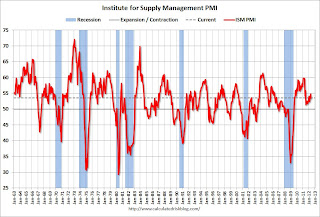 10:00 AM ET: ISM Manufacturing Index for June.
10:00 AM ET: ISM Manufacturing Index for June. Here is a long term graph of the ISM manufacturing index. The consensus is for a decrease to 52.0 from 53.5 in May.
10:00 AM: Construction Spending for May. The consensus is for a 0.2% increase in construction spending.
Early: Reis Q2 2012 Office vacancy rates.
All day: Light vehicle sales for June. Light vehicle sales are expected to increase to 13.9 million from 13.8 million in May (Seasonally Adjusted Annual Rate).
 This graph shows light vehicle sales since the BEA started keeping data in 1967. The dashed line is the May sales rate.
This graph shows light vehicle sales since the BEA started keeping data in 1967. The dashed line is the May sales rate. TrueCar is forecasting:
The June 2012 forecast translates into a Seasonally Adjusted Annualized Rate (SAAR) of 13.6 million new car sales, up from 11.5 million in June 2011 and down from 13.8 million in May 2012Edmunds.com is forecasting:
[A]n estimated Seasonally Adjusted Annual Rate (SAAR) this month of 13.9 million light vehicles, according to Edmunds.com.10:00 AM: Manufacturers' Shipments, Inventories and Orders (Factory Orders) for May. The consensus is for a 0.1% increase in orders.
10:00 AM: Trulia Price & Rent Monitors for June. This is the new index from Trulia that uses asking prices adjusted both for the mix of homes listed for sale and for seasonal factors.
SIFMA recommends US markets close at 2:00 PM ET in advance of the Independence Day Holiday on July 4th.
All US markets will be closed in observance of the Independence Day holiday.
Early: Reis Q2 2012 Apartment vacancy rates.
7:00 AM: The Mortgage Bankers Association (MBA) will release the mortgage purchase applications index. Refinance activity has increased sharply, and it appears purchase activity is increasing a little too.
8:15 AM: The ADP Employment Report for June. This report is for private payrolls only (no government). The consensus is for 95,000 payroll jobs added in June, down from the 133,000 reported last month.
8:30 AM: The initial weekly unemployment claims report will be released. The consensus is for claims to be unchanged at 386 thousand.
 10:00 AM: ISM non-Manufacturing Index for June. The consensus is for a decrease to 53.0 from 53.7 in May. Note: Above 50 indicates expansion, below 50 contraction.
10:00 AM: ISM non-Manufacturing Index for June. The consensus is for a decrease to 53.0 from 53.7 in May. Note: Above 50 indicates expansion, below 50 contraction.This graph shows the ISM non-manufacturing index (started in January 2008) and the ISM non-manufacturing employment diffusion index.
Early: Reis Q2 2012 Mall vacancy rates.
 8:30 AM: Employment Report for June. The consensus is for an increase of 90,000 non-farm payroll jobs in June, up from the 69,000 jobs added in May.
8:30 AM: Employment Report for June. The consensus is for an increase of 90,000 non-farm payroll jobs in June, up from the 69,000 jobs added in May.The consensus is for the unemployment rate to remain unchanged at 8.2%.
This second employment graph shows the percentage of payroll jobs lost during post WWII recessions through May.
 The economy has added 3.77 million jobs since employment bottomed in February 2010 (4.27 million private sector jobs added, and 502 thousand public sector jobs lost).
The economy has added 3.77 million jobs since employment bottomed in February 2010 (4.27 million private sector jobs added, and 502 thousand public sector jobs lost).There are still 4.7 million fewer private sector jobs now than when the recession started in 2007. (5.0 million fewer total nonfarm jobs).
Summary for Week ending June 29th
by Calculated Risk on 6/30/2012 08:01:00 AM
The top economic story last week was the eurozone deal. From the Financial Times:
The agreement will result in EU bailout funds eventually being injected directly into teetering Spanish financial institutions, meaning Madrid can sweep the burden of the bailouts off its sovereign books.As always, beware of the details!
However, the rescue for Spain’s banks will only come after the creation of a single banking supervisor to be run by the European Central Bank.
The summit agreement also contained some concessions for Italy ... setting the stage for Rome to become the sixth eurozone country to request EU assistance ...
excerpt with permission
In the US, housing continues to improves, however manufacturing was soft in June - and consumer spending was flat in May. For housing, new home sales were up solidly, and house prices - as reported by Case-Shiller - increased in April. Also the Pending Home sales index increased 5.9% in May.
Here is a summary of last week in graphs:
• New Home Sales increased in May to 369,000 Annual Rate
 Click on graph for larger image in graph gallery.
Click on graph for larger image in graph gallery.The Census Bureau reports New Home Sales in May were at a seasonally adjusted annual rate (SAAR) of 369 thousand. This was up from 343 thousand SAAR in April. Sales in February and March were revised up.
The first graph shows New Home Sales vs. recessions since 1963. The dashed line is the current sales rate.
On inventory, according to the Census Bureau:
"A house is considered for sale when a permit to build has been issued in permit-issuing places or work has begun on the footings or foundation in nonpermit areas and a sales contract has not been signed nor a deposit accepted."Starting in 1973 the Census Bureau broke this down into three categories: Not Started, Under Construction, and Completed.
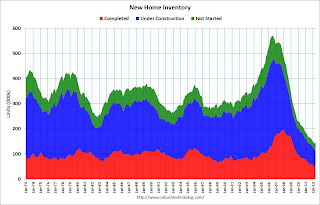 This graph shows the three categories of inventory starting in 1973.
This graph shows the three categories of inventory starting in 1973.The inventory of completed homes for sale was at a record low 43,000 units in May. The combined total of completed and under construction is at the lowest level since this series started.
New home sales have averaged 353 thousand SAAR over the first 5 months of 2012, after averaging under 300 thousand for the previous 18 months. All of the recent revisions have been up too. This was a very solid report and above the consensus forecast.
• Case Shiller: House Prices increased in April
 S&P/Case-Shiller released the monthly Home Price Indices for April (a 3 month average of February, March and April).
S&P/Case-Shiller released the monthly Home Price Indices for April (a 3 month average of February, March and April).This first graph shows the nominal seasonally adjusted Composite 10 and Composite 20 indices (the Composite 20 was started in January 2000).
The Composite 10 index is off 33.3% from the peak, and up 0.7% in April (SA). The Composite 10 is up from the post bubble low set in March, Not Seasonally Adjusted (NSA).
The Composite 20 index is off 33.0% from the peak, and up 0.7% (SA) in April. The Composite 20 is also up from the post-bubble low set in March (NSA).
 The second graph shows the Year over year change in both indices.
The second graph shows the Year over year change in both indices.The Composite 10 SA is down 2.2% compared to April 2011.
The Composite 20 SA is down 1.9% compared to April 2011. This was a smaller year-over-year decline for both indexes than in March.
The third graph shows the price declines from the peak for each city included in S&P/Case-Shiller indices.
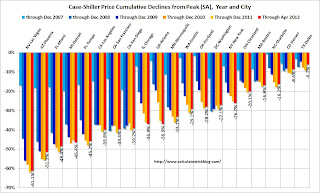 Prices increased (SA) in 17 of the 20 Case-Shiller cities in April seasonally adjusted (18 cities increased NSA). Prices in Las Vegas are off 61.1% from the peak, and prices in Dallas only off 6.2% from the peak. Note that the red column (cumulative decline through April 2012) is the lowest for only a couple of cities.
Prices increased (SA) in 17 of the 20 Case-Shiller cities in April seasonally adjusted (18 cities increased NSA). Prices in Las Vegas are off 61.1% from the peak, and prices in Dallas only off 6.2% from the peak. Note that the red column (cumulative decline through April 2012) is the lowest for only a couple of cities.This was better than the consensus forecast, and the NSA indexes are above the post-bubble lows set last month (NSA).
• Real House Prices and Price-to-Rent Ratio
Case-Shiller, CoreLogic and others report nominal house prices, and it is also useful to look at house prices in real terms (adjusted for inflation) and as a price-to-rent ratio. Below are three graphs showing nominal prices (as reported), real prices and a price-to-rent ratio. Real prices, and the price-to-rent ratio, are back to late 1998 and early 2000 levels depending on the index.
 This graph shows the quarterly Case-Shiller National Index SA (through Q1 2012), and the monthly Case-Shiller Composite 20 SA and CoreLogic House Price Indexes (through April) in nominal terms as reported.
This graph shows the quarterly Case-Shiller National Index SA (through Q1 2012), and the monthly Case-Shiller Composite 20 SA and CoreLogic House Price Indexes (through April) in nominal terms as reported.In nominal terms, the Case-Shiller National index (SA) is back to Q4 2002 levels, and even with the recent small increase, the Case-Shiller Composite 20 Index (SA) is back to March 2003 levels, and the CoreLogic index (NSA) is back to May 2003.
 The second graph shows the same three indexes in real terms (adjusted for inflation using CPI less Shelter). Note: some people use other inflation measures to adjust for real prices.
The second graph shows the same three indexes in real terms (adjusted for inflation using CPI less Shelter). Note: some people use other inflation measures to adjust for real prices.In real terms, the National index is back to Q4 1998 levels, the Composite 20 index is back to March 2000, and the CoreLogic index back to February 2000.
As we've discussed before, in real terms, all of the appreciation in the '00s is gone.
 This graph shows a price to rent ratio using the Case-Shiller National, Composite 20 and CoreLogic House Price Indexes.
This graph shows a price to rent ratio using the Case-Shiller National, Composite 20 and CoreLogic House Price Indexes.This graph shows the price to rent ratio (January 1998 = 1.0).
On a price-to-rent basis, the Case-Shiller National index is back to Q4 1998 levels, the Composite 20 index is back to March 2000 levels, and the CoreLogic index is back to April 2000.
In real terms - and as a price-to-rent ratio - prices are mostly back to late 1990s or early 2000 levels.
• Personal Income increased 0.2% in May, Spending decreased slightly
 The BEA released the Personal Income and Outlays report for May.
The BEA released the Personal Income and Outlays report for May.
This graph shows real PCE by month for the last few years. The dashed red lines are the quarterly levels for real PCE. You can really see the slow down in Q2 of last year.
Using the two-month method, it appears real PCE will increase around 1.4% in Q2 (PCE is the largest component of GDP); the mid-month method suggests an increase of less than 1% in Q2. Also - so far - it appears spending is soft in June, so Q2 PCE growth will probably be fairly weak.
Another key point is the PCE price index has only increased 1.5% over the last year, and core PCE is up 1.8%. And it looks like the year-over-year increases will decline further in June.
• Weekly Initial Unemployment Claims mostly unchanged
 The DOL reports:
The DOL reports:In the week ending June 23, the advance figure for seasonally adjusted initial claims was 386,000, a decrease of 6,000 from the previous week's revised figure of 392,000. The 4-week moving average was 386,750, a decrease of 750 from the previous week's revised average of 387,500.
The dashed line on the graph is the current 4-week average. The four-week average of weekly unemployment claims declined slightly to 386,750.
This is just off the high for the year.
• Regional Manufacturing Surveys
Regional surveys were mostly weak in June with the exception of the Dallas survey. From the Kansas City Fed: Growth in Tenth District Manufacturing Eased Further Activity Slowed
From the Richmond Fed: Manufacturing Activity Eased in June, But Expectations Remained Upbeat
From the Dallas Fed: Texas Manufacturing Activity Surges but Outlook Largely Unchanged
Here is a graph comparing the regional Fed surveys and the ISM manufacturing index:
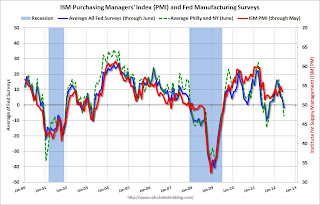 The New York and Philly Fed surveys are averaged together (dashed green, through June), and five Fed surveys are averaged (blue, through June) including New York, Philly, Richmond, Dallas and Kansas City. The Institute for Supply Management (ISM) PMI (red) is through May (right axis).
The New York and Philly Fed surveys are averaged together (dashed green, through June), and five Fed surveys are averaged (blue, through June) including New York, Philly, Richmond, Dallas and Kansas City. The Institute for Supply Management (ISM) PMI (red) is through May (right axis).The ISM index for June will be released Monday, July 2nd, and these surveys suggest some decrease from the 53.5 reading in May.
• Other Economic Stories ...
• NAR: Pending home sales index increased 5.9% in May
• Housing: Inventory and Negative Equity
• A QE Timeline
• Consumer Sentiment declines in June to 73.2


